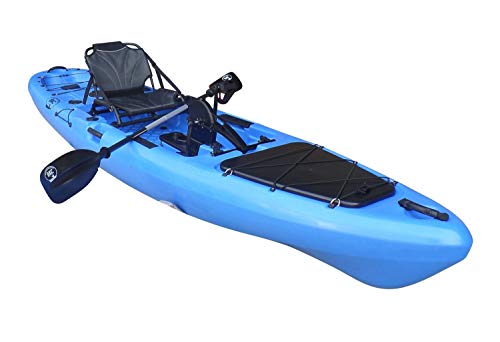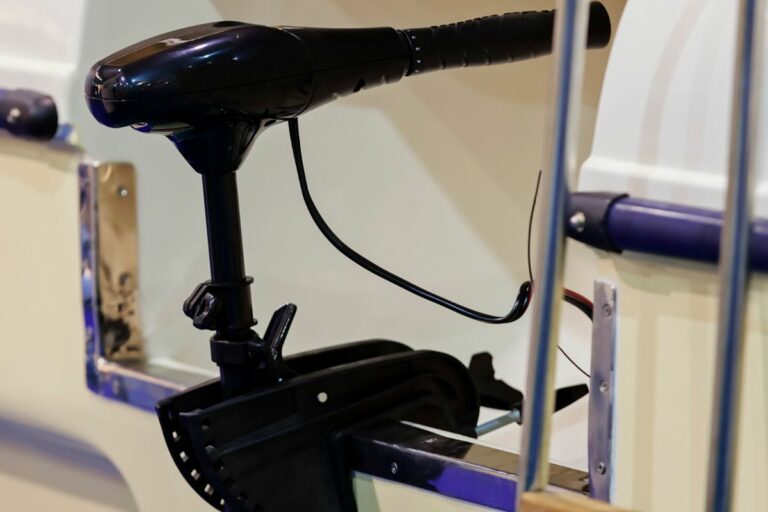Is There A Weight Limit for Kayaking? You Should Know This, Really
For many people who are overweight, finding enjoyable and effective ways to stay active can be a challenge. Kayaking is an outdoor activity that has gained popularity in recent years and may be of interest to those seeking a fun and low-impact way to exercise.
While people of all sizes can enjoy kayaking, it is essential to understand the limitations that come with the sport. So, is there a weight limit for kayaking?
There is a weight limit for kayaking, as most kayak models can support up to 250-350 pounds, including the weight of the paddler and any gear. Going over the kayak’s weight limit can affect the kayak’s maneuverability and stability, which can increase the risk of capsizing, among other issues.
Keep reading to learn more about why kayaks have weight limits and what happens if you go over your kayak’s weight limit.
Table of Contents
Is There A Weight Limit for Kayaking?

There is somewhat of a weight limit for kayaking, as each kayak is designed with a maximum weight capacity that should not be exceeded.
The average weight limit for kayaks is around 250-350 pounds; there are also some kayaks that can handle up to 600 pounds. However, the kayak’s weight limit can vary depending on the specific model and type of kayak.
If you’re unsure about the weight limit of a particular kayak, check the manufacturer’s specifications or consult with a professional.
Factors That Affect the Kayak’s Weight Limit
Several factors can affect a kayak’s weight limit, including:
- Type of kayak: Different types of kayaks are designed to perform in different conditions, and this can impact their weight limit. For example, touring kayaks are built for long-distance paddling and may have a higher weight limit than recreational kayaks that are designed for short, calm waters.
- Materials: Kayaks can be made from a variety of materials, including plastic, fiberglass, and carbon fiber. The type of material used can affect the weight limit of the kayak, as well as its durability and performance.
- Shape and size: The shape and size of a kayak can impact its weight limit. A wider kayak may be able to support more weight than a narrower one, while longer kayaks may be able to handle more weight due to their increased buoyancy.
When selecting a kayak, it’s important to consider all of these factors to ensure that you choose a kayak that can safely accommodate your weight and any additional gear you may have.
Can You Increase A Kayak’s Weight Limit?
The weight limit of a kayak is determined by the manufacturer based on the design, size, and materials used in its construction.
It is not recommended to attempt to modify a kayak to increase its weight limit, as it can compromise the stability of the kayak and may cause irreversible damage. However, there are ways to do it safely, such as properly distributing the weight in the kayak or adding flotation devices to increase buoyancy.
You can learn more ways to increase the weight limit of your kayak here.
If you still find that your current kayak is not able to accommodate your weight or the weight of your gear, it is recommended to consider purchasing a larger kayak or one with a higher weight capacity that is designed to meet your needs.
Can You Go Over the Weight Limit on a Kayak?

It is not recommended to go over the weight limit of a kayak as it can affect the kayak’s maneuverability and stability, which can compromise your safety on the water.
When a kayak is overloaded, it sits lower in the water. The lower position in the water also creates more drag, making it more challenging to paddle and causing the paddler to become fatigued more quickly.
Additionally, an overloaded kayak may not be able to handle changes in water conditions such as wind, waves, or currents, increasing the risk of capsizing. In rough water conditions, this can be particularly dangerous, as you may not be able to remain stable or recover from a wave.
Furthermore, exceeding the weight limit of a kayak can cause damage to the kayak itself, particularly if it is a lightweight recreational kayak or an inflatable kayak. The extra weight can put a strain on the kayak’s seams, causing them to tear or burst.
So, it is very important not to overload your kayak and to follow the manufacturer’s recommended weight limit to ensure your safety out on the water.
What Weight Limit to Look for When Purchasing a Kayak?
When purchasing a kayak, it’s important to look for a weight limit that can accommodate your weight and any additional gear you may have. The weight limit is usually listed in the kayak’s specifications and can vary depending on the type and model of the kayak.
How to Calculate the Weight Limit for Optimal Performance?
Calculating the kayak’s weight limit for optimal performance can be a bit tricky as it depends on several factors, such as the type of kayak, the paddler’s weight, the type of water, and the gear being carried.
However, a general rule of thumb is to look for a kayak weight limit that is at least 20% more than the paddler’s weight and any additional gear.
To calculate the weight limit, you can follow these steps:
- Weigh yourself or the intended paddler while wearing any gear that you would typically wear while kayaking.
- Add the weight of any additional gear. This includes things like paddles, life jackets, and any other equipment you plan to bring to the kayak.
- Multiply the total weight by 1.2 to get the weight limit that is 20% more than the total weight.
For example, if the paddler weighs 200 pounds and the gear weighs 20 pounds, the total weight is 220 pounds. Multiplying by 1.2 gives a weight limit of 264 pounds. This means that a kayak with a weight capacity of at least 264 pounds would be ideal for optimal performance.
Keep in mind that this is a general guideline, and there may be other factors to consider depending on the specific kayak and condition, so it’s always a good idea to check the kayak manufacturer’s recommendations.
Can You Kayak If You’re Overweight?
You can kayak if you’re overweight as long as you choose a kayak with a weight limit that can accommodate you and your gear, and make sure not to exceed that weight limit.
A sit-on-top kayak can be a good option as it is usually wider and more stable than a sit-inside kayak. I recommend this Brooklyn Kayak Company PK13 sit-on-top kayak with a weight capacity of 550 pounds. You can check out my other recommendations for the best sit-on-top kayaks here.
There are also some measures you need to take to ensure your safety, including:
- Always use a personal flotation device (PFD): It’s important to wear a properly fitting PFD at all times while kayaking. A PFD will keep you buoyant in case of an accident and help you stay afloat in the water.
- Wear Appropriate Clothing: Wear clothing that is comfortable, breathable, and allows for freedom of movement. Avoid tight-fitting clothes that can restrict your movements or circulation.
- Adjust the Kayak: Make sure the kayak is adjusted to fit your body size and shape. Adjust the foot pedals, seat back, and any other adjustable features to ensure a comfortable fit.
- Practice good technique: Proper paddling technique can help you conserve energy and reduce the risk of injury. It is essential to use your core muscles and legs to power your strokes rather than relying solely on your arms.
- Start Slowly: Start with shorter paddling sessions and gradually increase the duration and intensity of your paddling as you build up strength and endurance.
- Kayak with a partner: Kayaking with a partner can provide you with additional support and safety. It can also make the experience more enjoyable and social.
Remember to always prioritize your safety and comfort while kayaking, and If you have any medical conditions or concerns related to your weight, it’s always a good idea to consult with your healthcare provider before engaging in any physical activity.
Kayak Recommendations for Those on the Heavier Side
There are quite a few kayaks to choose from, but here are my favorite picks:
My top pick is this Brooklyn Kayak Company PK13 sit-on-top kayak. It’s an excellent choice for overweight individuals looking for a stable and comfortable kayak.
With a weight capacity of up to 550 pounds, it can easily accommodate larger paddlers. Additionally, the adjustable footrests and padded seat provide added comfort for extended paddling sessions.
The BOTE Zeppelin Aero Inflatable Kayak is another ideal choice for overweight individuals, especially those on a tighter budget.
The inflatable design makes it easy to transport and store, and the durable material can handle weights up to 500 pounds. The wide design also provides added stability and reduces the risk of capsizing.
Kayak your way to Freedom
- On a budget? Check out the best fishing kayaks under $500 here and the best Fishing Kayaks under $1,000 here. Or Check the best Cheap Kayaks here.
- Going fishing? Here are the best Ocean fishing kayaks, and here are the best River Fishing Kayaks.
- You can also find the best Fly Fishing Kayaks here and the best Bass Fishing Boats here.
- A bit experienced? Check out the best modular kayaks here and the best tandem fishing kayaks here.
- Looking for something special? Check out my favorite Ducky kayaks here.
- Navigate your way with these awesome and beginner-friendly Kayak compasses.
- Going Hunting? These Duck hunting kayaks will give you an unfair advantage!
- Have a need for speed? These motorized kayaks will get you moving.
- Protect yourself from the sun with these Kayak shades, and make your kayak more comfortable with these Kayak seats.
- Keep your feet dry and warm with these superb Kayaking shoes.
- Going Kayaking in cold water? Stay warm with these Kayaking gloves.
- Paddle Less, Fish More with the Best Kayak Motors
- Looking to get a trolling motor on your kayak? Check out the best kayak trolling motor mounts here.
If you like this article, please share it or pin it, you can find the share buttons below. We will really appreciate it ❤️










